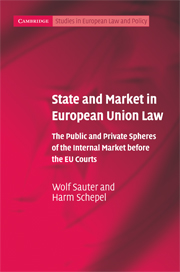 State and Market in European Union Law
State and Market in European Union Law Book contents
- Frontmatter
- Contents
- Acknowledgements
- Abbreviations
- Table of Cases
- 1 Introduction
- PART I Economic activities v. the exercise of public authority
- PART II The Public Private Interface: Articles 31, 86 and 87–88 EC
- 5 Article 31 EC: commercial state monopolies
- 6 Article 86(1): public undertakings, special and exclusive rights
- 7 Article 86(2) EC: derogation for services of general economic interest (SGEI)
- 8 Articles 87–88 EC: State aid
- 9 Conclusion
- References
- Index
- CAMBRIDGE STUDIES IN EUROPEAN LAW AND POLICY
9 - Conclusion
Published online by Cambridge University Press: 22 January 2010
- Frontmatter
- Contents
- Acknowledgements
- Abbreviations
- Table of Cases
- 1 Introduction
- PART I Economic activities v. the exercise of public authority
- PART II The Public Private Interface: Articles 31, 86 and 87–88 EC
- 5 Article 31 EC: commercial state monopolies
- 6 Article 86(1): public undertakings, special and exclusive rights
- 7 Article 86(2) EC: derogation for services of general economic interest (SGEI)
- 8 Articles 87–88 EC: State aid
- 9 Conclusion
- References
- Index
- CAMBRIDGE STUDIES IN EUROPEAN LAW AND POLICY
Summary
When we started this book, we were struck by the contradiction between the assertive European law that we learned as students in the heady days of the Single European Act and the cautious approach adopted by the Court from the early 1990s onward. In short: we were challenged by the clash between Cassis de Dijon, when mutual recognition seemed to make short shrift of discriminatory State measures, and Keck, which seemed to accept barriers to trade provided only they did not entail deliberate discrimination. Almost contemporaneously similar developments appeared to take place concerning the public promotion of private restraints on competition, where the high hopes raised by Van Eycke were dashed by Meng, Reiff and Ohra.
Our original aim, therefore, was to make sense of the free movement and competition case law of the European courts, to compare the two, and to reconcile them where possible. In addition, we thought we would draw up the balance of the Court's retrenching that appeared to occur on all fronts at the time.
In the course of our writing on this topic we have discovered not only that ours was a moving target, but also that the rules of the game were far more flexible than originally thought – as evidenced, for example, by: the remarkable teleology applied in the Albany judgment, where the Court found an unwritten exception to the competition rules in the Treaty for the results of collective bargaining; Wouters, where public interest claims by private parties justified corporatist arrangements as outside the scope of the Article 81(1) EC prohibition; and Medina, the clearest suggestion to date that the Court is headed for a rule of reason (such as it already adopted in free movement with Dassonville) in competition law.
- Type
- Chapter
- Information
- State and Market in European Union LawThe Public and Private Spheres of the Internal Market before the EU Courts, pp. 211 - 221Publisher: Cambridge University PressPrint publication year: 2009
